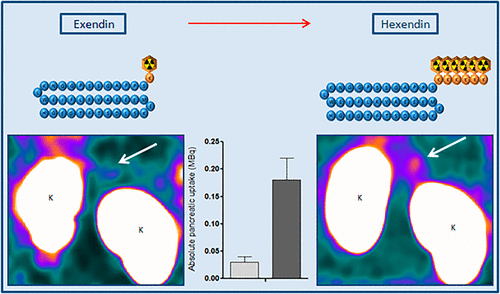当前位置:
X-MOL 学术
›
Mol. Pharmaceutics
›
论文详情
Our official English website, www.x-mol.net, welcomes your feedback! (Note: you will need to create a separate account there.)
Enhanced Specific Activity by Multichelation of Exendin-3 Leads To Improved Image Quality and In Vivo Beta Cell Imaging.
Molecular Pharmaceutics ( IF 4.9 ) Pub Date : 2017-12-21 , DOI: 10.1021/acs.molpharmaceut.7b00853 Lieke Joosten 1 , Maarten Brom 1 , Hanneke Peeters 1 , Sandra Heskamp 1 , Martin Béhé 2 , Otto Boerman 1 , Martin Gotthardt 1
Molecular Pharmaceutics ( IF 4.9 ) Pub Date : 2017-12-21 , DOI: 10.1021/acs.molpharmaceut.7b00853 Lieke Joosten 1 , Maarten Brom 1 , Hanneke Peeters 1 , Sandra Heskamp 1 , Martin Béhé 2 , Otto Boerman 1 , Martin Gotthardt 1
Affiliation

|
Glucagon-like peptide-1 receptor (GLP-1R) targeting using radiolabeled exendin is a promising approach to noninvasively visualize and determine beta cell mass (BCM), which could help to unravel the pathophysiology of diabetes. However, saturation of the GLP-1R on beta cells occurs at low peptide doses, since the number of receptors expressed under physiological conditions is low. Therefore, tracers with high specific activities are required to sensitively image small variations in BCM. Here, we describe a novel exendin-3-based radiotracer with multiple chelators and determine its potential for in vivo beta cell imaging. Exendin-3 was modified by adding six lysine residues C-terminally conjugated with one, two, or six DTPA moieties. All compounds were labeled with 111In and their GLP-1R affinity was determined in vitro using GLP-1R expressing cells. The in vivo behavior of the 111In-labeled tracers was examined in BALB/c nude mice with a subcutaneous GLP-1R expressing tumor (INS-1). Brown Norway rats were used for SPECT visualization of the pancreatic BCM. Addition of six lysine and six DTPA residues (hexendin(40-45)) resulted in a 7-fold increase in specific activity (from 0.73 GBq/nmol to 5.54 GBq/nmol). IC50 values varied between 5.2 and 69.5 nM. All compounds with two or six lysine and DTPA residues had a significantly lower receptor affinity than [Lys40(DTPA)]exendin-3 (4.4 nM, p < 0.05). The biodistribution in mice revealed no significant decrease in pancreatic uptake after addition of six lysine and DTPA molecules. Hexendin(40-45) showed a 6-fold increase in absolute 111In uptake in the pancreas of Brown Norway rats compared to [Lys40(DTPA)]exendin-3 (182.7 ± 42.3 kBq vs 28.8 ± 6.0 kBq, p < 0.001). Visualization of the pancreas on SPECT was improved using hexendin(40-45), due to the higher count rate, achieved at the same peptide dose. In conclusion, hexendin(40-45) showed an improved visualization of the pancreas with SPECT. This tracer holds promise to sensitively and specifically detect small variations in BCM.
中文翻译:

Exendin-3的多螯合增强的比活性可改善图像质量和体内Beta细胞成像。
使用放射性标记的exendin靶向胰高血糖素样肽-1受体(GLP-1R)是一种有前景的方法,可以无创地观察和确定β细胞团块(BCM),这有助于弄清糖尿病的病理生理学。但是,由于在生理条件下表达的受体数量很少,因此在低肽剂量下,β细胞上的GLP-1R就会饱和。因此,需要具有高比活度的示踪剂来灵敏地成像BCM中的细微变化。在这里,我们描述了一种具有多种螯合剂的新颖的基于exendin-3的放射性示踪剂,并确定了其在体内β细胞成像中的潜力。通过添加六个C末端与一个,两个或六个DTPA部分共轭的赖氨酸残基来修饰Exendin-3。所有化合物均用111 In标记,并使用表达GLP-1R的细胞体外测定其GLP-1R亲和力。在具有皮下表达GLP-1R的肿瘤(INS-1)的BALB / c裸鼠中检查了111In标记示踪剂的体内行为。棕色挪威大鼠用于胰腺BCM的SPECT可视化。添加六个赖氨酸和六个DTPA残基(hexendin(40-45))导致比活性提高了7倍(从0.73 GBq / nmol增加到5.54 GBq / nmol)。IC50值在5.2和69.5 nM之间变化。具有两个或六个赖氨酸和DTPA残基的所有化合物的受体亲和力均显着低于[Lys40(DTPA)] exendin-3(4.4 nM,p <0.05)。小鼠中的生物分布显示,添加六个赖氨酸和DTPA分子后,胰腺的摄取没有明显降低。Hexendin(40-45)显示,与[Lys40(DTPA)] exendin-3(182.7±42.3 kBq vs 28.8±6)相比,褐挪威大鼠胰腺的111In摄取绝对值增加了6倍。0 kBq,p <0.001)。使用hexendin(40-45)可以提高SPECT上胰腺的可视化效果,因为在相同的肽剂量下可以实现更高的计数率。总之,己烯丁(40-45)显示了使用SPECT改善的胰腺可视化。该示踪剂有望灵敏,特异地检测BCM中的细微变化。
更新日期:2017-12-21
中文翻译:

Exendin-3的多螯合增强的比活性可改善图像质量和体内Beta细胞成像。
使用放射性标记的exendin靶向胰高血糖素样肽-1受体(GLP-1R)是一种有前景的方法,可以无创地观察和确定β细胞团块(BCM),这有助于弄清糖尿病的病理生理学。但是,由于在生理条件下表达的受体数量很少,因此在低肽剂量下,β细胞上的GLP-1R就会饱和。因此,需要具有高比活度的示踪剂来灵敏地成像BCM中的细微变化。在这里,我们描述了一种具有多种螯合剂的新颖的基于exendin-3的放射性示踪剂,并确定了其在体内β细胞成像中的潜力。通过添加六个C末端与一个,两个或六个DTPA部分共轭的赖氨酸残基来修饰Exendin-3。所有化合物均用111 In标记,并使用表达GLP-1R的细胞体外测定其GLP-1R亲和力。在具有皮下表达GLP-1R的肿瘤(INS-1)的BALB / c裸鼠中检查了111In标记示踪剂的体内行为。棕色挪威大鼠用于胰腺BCM的SPECT可视化。添加六个赖氨酸和六个DTPA残基(hexendin(40-45))导致比活性提高了7倍(从0.73 GBq / nmol增加到5.54 GBq / nmol)。IC50值在5.2和69.5 nM之间变化。具有两个或六个赖氨酸和DTPA残基的所有化合物的受体亲和力均显着低于[Lys40(DTPA)] exendin-3(4.4 nM,p <0.05)。小鼠中的生物分布显示,添加六个赖氨酸和DTPA分子后,胰腺的摄取没有明显降低。Hexendin(40-45)显示,与[Lys40(DTPA)] exendin-3(182.7±42.3 kBq vs 28.8±6)相比,褐挪威大鼠胰腺的111In摄取绝对值增加了6倍。0 kBq,p <0.001)。使用hexendin(40-45)可以提高SPECT上胰腺的可视化效果,因为在相同的肽剂量下可以实现更高的计数率。总之,己烯丁(40-45)显示了使用SPECT改善的胰腺可视化。该示踪剂有望灵敏,特异地检测BCM中的细微变化。



























 京公网安备 11010802027423号
京公网安备 11010802027423号